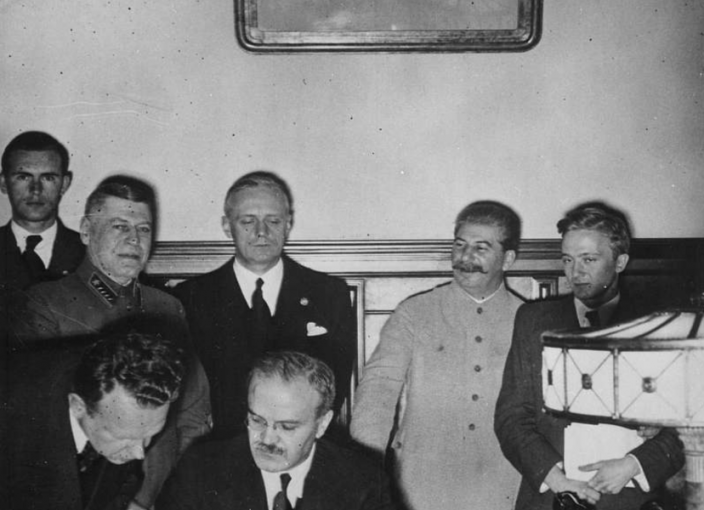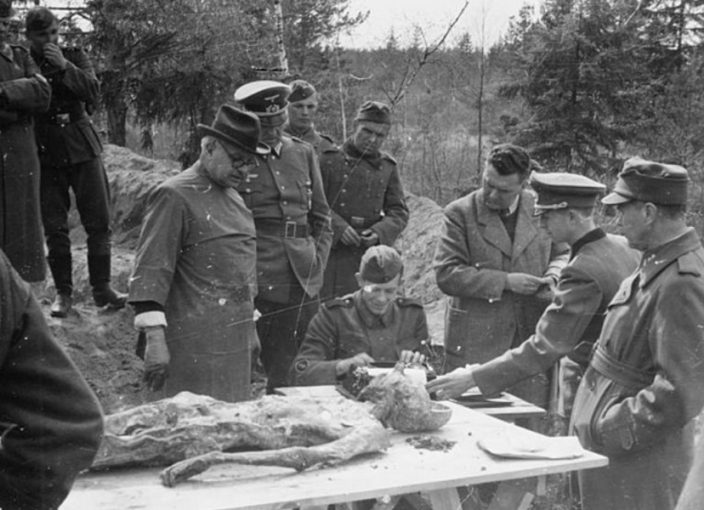Chapter 8
The Molotov-Ribbentrop Pact and the Katyn Massacre
“One body was placed on top of the other, with their faces down. They were close together, nothing between them. All the bodies were dressed in Polish officer uniforms, the heads were downward. One body like this, the next one like this, and the next one like this, and coats on some: The heads were downward like this, and the next one like this [indicating]. This was the width of the grave. Then 12 layers down and then multiply by the length. I don’t remember how many we found in the length. ... I estimated approximately 2,870, something like that, a little less than 3,000 officers. They were packed completely together by decaying fluids of the human body, the decomposing fluids which started to penetrate, to imbibe, to infiltrate every dead body in there. That was a solid mess in which you just saw skulls you could recognize and that they were human beings.”
Dr. Edward Lucas Miloslavich, an American-Croatian medical expert and pioneer in the field of forensic pathology, testified on his 1943 investigation of the Katyn Forest Massacre before a House select committee of the U.S. Congress in the early 1950s. For his honesty about the Soviet atrocity, he was sentenced to death in absentia by the Communist government of Yugoslavia.1
The Molotov-Ribbentrop Pact
Prior to WWII, Nazi Germany’s Foreign Minister, Joachim von Ribbentrop, and his Soviet counterpart, Vyacheslav Molotov, negotiated a treaty in Moscow that sealed the fate of millions across Europe. Signed on August 23, 1939, the Treaty of Non-Aggression between Germany and the Soviet Union commonly known as the Molotov-Ribbentrop Pact included a secret protocol that divided Poland, Romania, Finland, and the Baltic States into Soviet and German spheres of influence, and marked a significant step for the expanding empires of Adolf Hitler and Joseph Stalin.2 Nor was it the first time the USSR and Germany had co-operated. Throughout the 1920s and early 1930s, the Soviets had covertly assisted Germany in violating post-World War I treaty limits on military development, providing manufacturing facilities and raw materials to Germany in exchange for money, technological assistance, and military training.3 Despite their ideological differences, the secret alliance between Hitler and Stalin provided both totalitarian leaders what they most wanted: an opportunity for territorial expansion and a change in the power structure of Europe, which had long favored the British and French. Indeed, Stalin was so suspicious of the British, whom he perceived as the main imperialist enemy, that later, when British Prime Minister Winston Churchill attempted to warn him of Hitler’s intention to break the Pact and invade, he rejected both these reports and those of his own intelligence service.4
Specially targeted, Poland fell quickly to its stronger neighbors.5 Two weeks after the Nazi invasion, Stalin annexed the eastern part of Poland, declaring that “Poland…must cease to be a wall protecting Europe from Russia, and must become a bridge between Russia and Germany.”6 Hitler, meanwhile, achieved two of his main objectives: to avoid a major war on two fronts, and to turn on Western Europe before those nations could mobilize their full military potential. With Stalin’s cooperation, the Second World War had begun.
Signing of the Molotov-Ribbentrop Pact. Photo via Wikimedia Commons.
The Katyn Massacre
Ever the propagandist, Stalin claimed to be the liberator of Poland, rather than her conqueror. The Soviet press portrayed Poland as “a failed state,” the oppressor of ethnic minorities, and a security threat to Russia itself. Newspapers movingly described the euphoria with which peasants greeted advancing troops: “They throw themselves into their arms with tears of joy and offer apples and milk.”7 Russia’s mission was humanitarian in nature, they asserted, both welcome and necessary.8
The evidence suggests otherwise.
In April 1943, German investigators in occupied Russian territory unearthed over 4,000 Polish corpses in the Katyn Forest near Smolensk. The Soviet Union claimed that the invading German army had killed the Poles, but subsequent investigations exposed this as a lie and a cover-up—an attempt to whitewash the Soviet war crime known today as the Katyn Massacre.9
When Soviet troops invaded Poland on September 17, 1939, the Soviet security service (NKVD) followed hard on their heels. Hundreds of thousands of Polish citizens were arrested and interned as prisoners of war. Stalin personally ordered the execution of approximately 22,000 of these Polish officers, soldiers, and police in the infamous Katyn Massacre of 1940.10 Most were not professional soldiers, but reservists mobilized after Germany’s attack.11 The majority were educated men, such as doctors, civil servants, and teachers. Indeed, Stalin systematically targeted the nation’s elite to ensure not only the defeat of the Polish people, but also to eliminate the country’s current and potential leadership. As the key post-World War II U.S. Congressional investigation noted, “There can be no doubt that this massacre was a calculated plot to eliminate all Polish leaders who subsequently would have opposed the Soviets’ plans for communizing Poland.”12
Soviet authorities placed captured Poles in detention camps in September 1939. Some were released, but over 100,000 were sent to the Gulag. The condemned group of 23,000 officers, border-guards, and policemen were transferred to three separate camps in western Russia: Kozielsk, Starobielsk, and Ostashkov.13 They maintained contact with their families until the spring of 1940, when correspondence suddenly ceased.14 On March 5, 1940, the Soviet Union’s Commissioner of Internal Affairs, Lavrentiy Beria, recommended to Stalin that the prisoners of these camps be executed because “All of them are implacable enemies of Soviet power and full of hatred for the Soviet system.”15 That same day, Stalin’s Politburo approved the request and directed the NKVD to carry out the mass execution.16
Uncovering the Katyn Massacre, 1940. Photo via Wikimedia Commons.
By early April, the orders had arrived at the three “special camps” and other Soviet prisons, and the massacre began. Former NKVD officer A. I. Romanov later recalled that liquidation of “the flower of the officer corps of Poland” was regarded as “typical…quite routine and unremarkable in Soviet Russia.”17 Some of the killings occurred in prison cells, others in the forest. Executions were typically carried out at night and in strict secrecy, to conceal them from other prisoners and avoid riots or a revolt.18 One of Stalin’s chief executioners, V.M. Blokhin, took part in the slaughter, or as Stalin called it “black work.”19 Simone Sebag Montefiore writes:
Blokhin travelled down to Ostachkov camp where he and two other Chekists outfitted a hut with padded, soundproofed walls and decided on a Stakhanovite quota of 250 shootings a night. He brought a butcher’s leather apron and cap which he put on when he began one of the most prolific acts of mass murder by one individual, killing 7,000 in precisely 28 nights, using a German Walther pistol to prevent future exposure. The bodies were buried in various places – but the 4,500 in the Kozielsk camp were interred in Katyn Forest.”20
Over 20,000 Polish soldiers, interned as prisoners of war without war ever having been declared, were thus secretly executed and purged from memory.
Moscow would not acknowledge responsibility for the mass executions of the Poles until 1990, when Mikhail Gorbachev admitted Soviet guilt.21 For 45 years, Poland’s communist regime also repeated the lie that Nazi Germany was to blame. The Katyn Massacre remains an enduring symbol of Polish suffering.22 The Soviet campaign of denial and disinformation came to be known as the Katyn Lie (kłamstwo katyńskie).23 For many Poles today, Katyn epitomizes the injustice and pain their country suffered during and after World War II, when its powerful totalitarian neighbors carved up and devoured the Polish nation.




